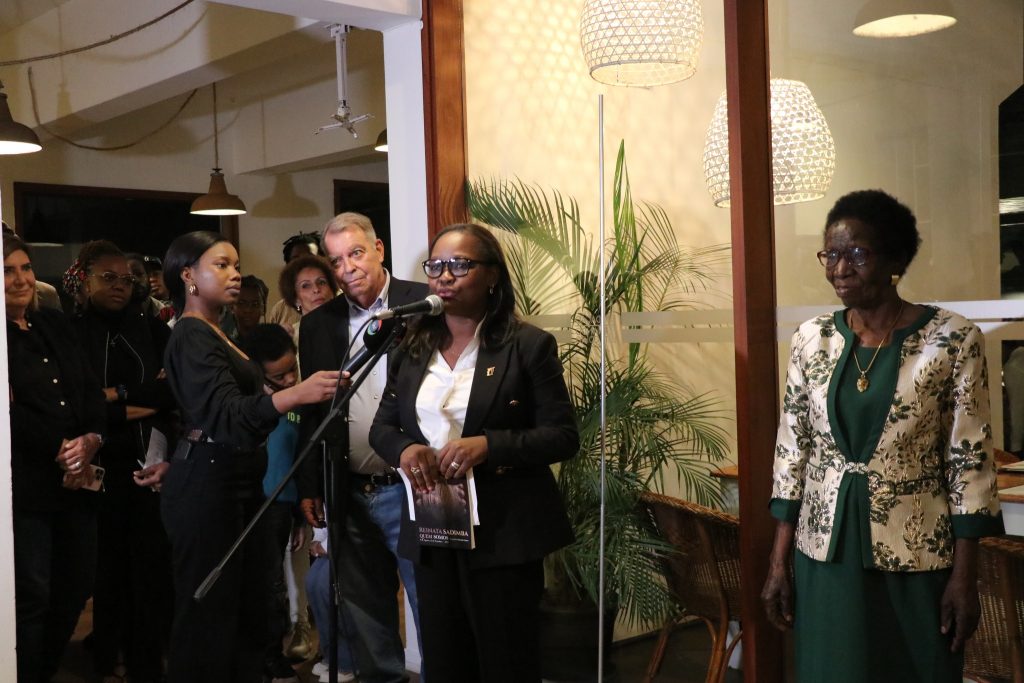Mozambique: Maputo Port launches Amateur Photo Contest 'A Ver Navios'
Mozambique: Reinata Sadimba opens ‘Quem Somos’ in Maputo

Reinata Sadimba (left) pictured here with Minister of Culture and Tourism Eledevina Materula at the opening of 'Who We Are?, at the Fundação Fernando Leite Couto, in Maputo, on Wednesday. [Photo: Ministério da Cultura e Turismo]
The Minister of Culture and Tourism, Eldevina Materula, on Wednesday attended the opening of an exhibition at the Fernando Leite Couto Foundation in Maputo by renowned Mozambican ceramist, Reinata Sadimba, entitled ‘Quem Somos’ [“Who We Are”].
In her new collection of works, Reinata Sadimba transcends the borders of Mozambique, creating works in ceramics with a narrative and aesthetics that refer to the essence of humanity: relationships, union, family, the faces that symbolise lives and experiences of people from her land that she has always tried to portray with the peculiarity that only her talent can achieve.
In a brief intervention, Minister Eldevina Materula acknowledged Reinata’s greatness and the unique and authentic way she has of making her works.

Materula added that the artist is one of the best sellers abroad, magnifying Mozambican culture around the world, and urged the public to go and see the exhibition as a way of honouring the artist.
In “Quem Somos”, the ceramist, more than shaping the bodies, makes a representation of stories that link the traditional to the modern. The figures, with exaggerated shapes and poorly defined features, are the representation of the sacred mystery where, at times, a deep fantasy and tragic humanity is condensed.
The exhibition will be open until September 2nd.
About Reinata Sadimba

Reinata Sadimba was born in Nemu, a village in Mueda, Mozambique, in 1945. She received a traditional Makonde education, which included making useful objects out of clay. She learned the art of ceramics from her mother, with the initial aim of providing for her family after her father died when she was very young. However, she eventually found that working with clay allowed her to “say things that I did not know how to express in any other way”.
As a young woman, Sadimba joined FRELIMO and the armed resistance to Portuguese rule in Mozambique that began in 1964. After the Mozambican War of Independence, the country gained independent status in 1975.
Sadimba’s work is marked by her own personal experiences. Married young and twice divorced, she had eight children, of whom only one survives. After leaving an abusive marriage in 1975, Sadimba revolutionised her work, beginning to add personalised elements that distinguished her pieces from other Makonde ceramics
In the 1980s, she collaborated on a rural project with a Swiss couple who had settled close to Mueda, where she was living at the time. This project brought more visibility to her work. However, as the Mozambican Civil War raged, she emigrated in 1985 with her only son to Tanzania, where she lived in Dar es Salaam with her sister Josefina. It was there that she began to exhibit her work in small galleries and artisanal markets.
The Swiss couple’s continued support gave her the financial stability to experiment artistically with new techniques and sculpt according to her own aesthetic and imagination. During her time in Tanzania, she further developed her stylistic depiction of the human form, while still reflecting the Makonde matrilineal universe.
In 1992, after the end of the war, she returned to Mozambique and settled in Maputo. There, she received significant support from Augusto Cabral, then the director of the Mozambique Natural History Museum, and established a studio within the museum. In 1998, her work was featured during a week-long educational programme on traditional ceramics at the museum.
In her work, Sadimba uses clay as well as white limestone and graphite, which gives her pieces their characteristic green colour. She creates jugs, pots, and anthropomorphic forms, which often display the scarifications or cultural marks typical of the Makonde people. Sadimba herself has a tattooed face, in keeping with Makonde tradition. Her ceramics contain layers of meaning and make reference to stories and legends of her home province, often depicting femininity, motherhood, or childbirth. She is also renowned for producing pieces incredibly quickly.
Sadimba’s work has been exhibited both in Mozambique and abroad, including in South Africa, Italy, Switzerland, Portugal, and France. In 2022, she was named a Commander of the Order of Prince Henry by the president of Portugal.













Leave a Reply
Be the First to Comment!
You must be logged in to post a comment.
You must be logged in to post a comment.